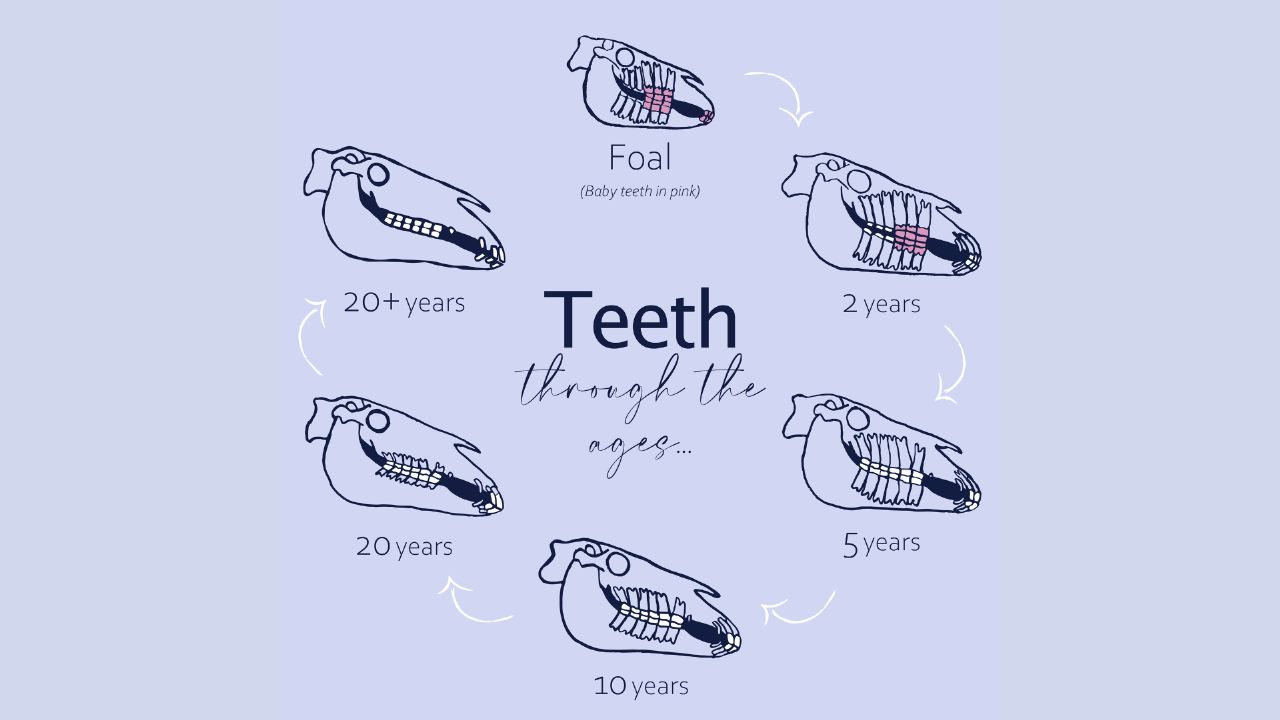10 years of Simple System HayCare!
During its 10 years so far, it has become apparent that HayCare is so much more than a hay replacer...

Horses’ teeth change throughout their lives - they are continually growing and continually wearing, as they chew and grind their grazing and forage. This means that regular checks from a suitably qualified Equine Dental Technician or vet are recommended - even when horses are not yet in work, or once they have retired.
As foals, the first teeth begin to erupt from just one to two weeks after birth. By the time they reach 9 months old, most will have a full set of 24 teeth.
Just like people, foals have ‘baby teeth’, as depicted in the illustration. These teeth are replaced by adult teeth usually between the ages of 3 and 5.
When the adult teeth erupt, they dislodge the first teeth, which are also known as caps. Whilst this is happening it can make chewing very uncomfortable, especially long fibre forages (such as hay) and short grazing that is being eaten close to ground level. This is one of the main causes of sudden loss of condition in otherwise healthy youngsters. Offering soaked feeds and hay replacers like HayCare® will be far easier for the youngster to manage and so ought to help them maintain or regain condition.
Whilst dental checks are recommended at least once a year, youngsters (and older horses) may require more frequent checks. If you have any concerns about your horse’s body condition or if they are having difficulty chewing, do contact your vet or Equine Dental Technician (EDT). Once the adult teeth have come in at around 5, the teeth continue to change both on the surface and importantly, below it.
By the time the horse has reached the age of 15 to 16, dental issues are very common. Some can be minimised with regular dental care in earlier life, and appropriate feeding also has a part to play. Peripheral caries (or cavities in human terms) for example, are deemed less likely to occur when horses have low sugar, low starch diets.
On the surface, two frequently seen issues are wear of the crown (grinding surface) and diastema (gaps between the teeth).
Diastema are problematic as food can become compacted and trapped, causing painful inflammation of the gums and periodontal tissue - even leading to infection in some cases. Your EDT or vet will advise of any treatment required, which may range from flushing and washing to widening the gaps themselves. From a feeding perspective, we suggest avoiding chops or chaffs in the diet as these can cause irritation. Instead, opt for soaked forages.
When the horse has reached their early 20’s it is likely that the rate of wear on the crown is more than the rate of eruption. Their teeth are wearing out. This can make chewing forage difficult and you may notice that they are quidding hay. This suggests it is time to offer an alternative forage to replace hay - HayCare® being the obvious choice as it is nutritionally likened to good quality high fibre hay, yet it is in an easier to manage format when fed soaked.
Finally, the (quite literal) root cause of weight loss in many older horses comes from beneath the gums. As horses age, the roots of their teeth become more shallow in the jaw - a result of the continual growth (eruptions) of the teeth during their lifetime. This can lead to the teeth themselves being less stable, making chewing uncomfortable. Again, offering an easier to eat soaked hay replacer is recommended.
If you are not sure that your horse requires a hay replacer, there are some key signs to look out for. Your horse may display one, or several of the following...
If you are seeing any of the signs listed above, we suggest consulting with your vet.
When introducing a hay replacer, as with all dietary changes, do so gradually over a week or so. It is important to note that an insufficient intake of forage can increase the risk of digestive issues, including colic.
Hay replacers need to be fed in hay-replacing quantities. For example, if you wish to replace 6kg of hay, you will need to use 6kg dry weight of hay replacer.
For tailored nutritional advice for your horse or pony, contact the Simple System Feed Line on 01728 604 008 or complete the advice request form here, for a free Feed Plan.
During its 10 years so far, it has become apparent that HayCare is so much more than a hay replacer...
Grass has the potential to grow all year, which is different from many other plants. Certain things are necessary for this growth, but if they are not met, the grass will be dormant, waiting for conditions to improve.Â
Rain fall can trigger growth akin to a spring flush, especially if temperatures are high. Even whilst true spring may be in the past, the risk for those prone to laminitis will rise.